What’s in your bag?
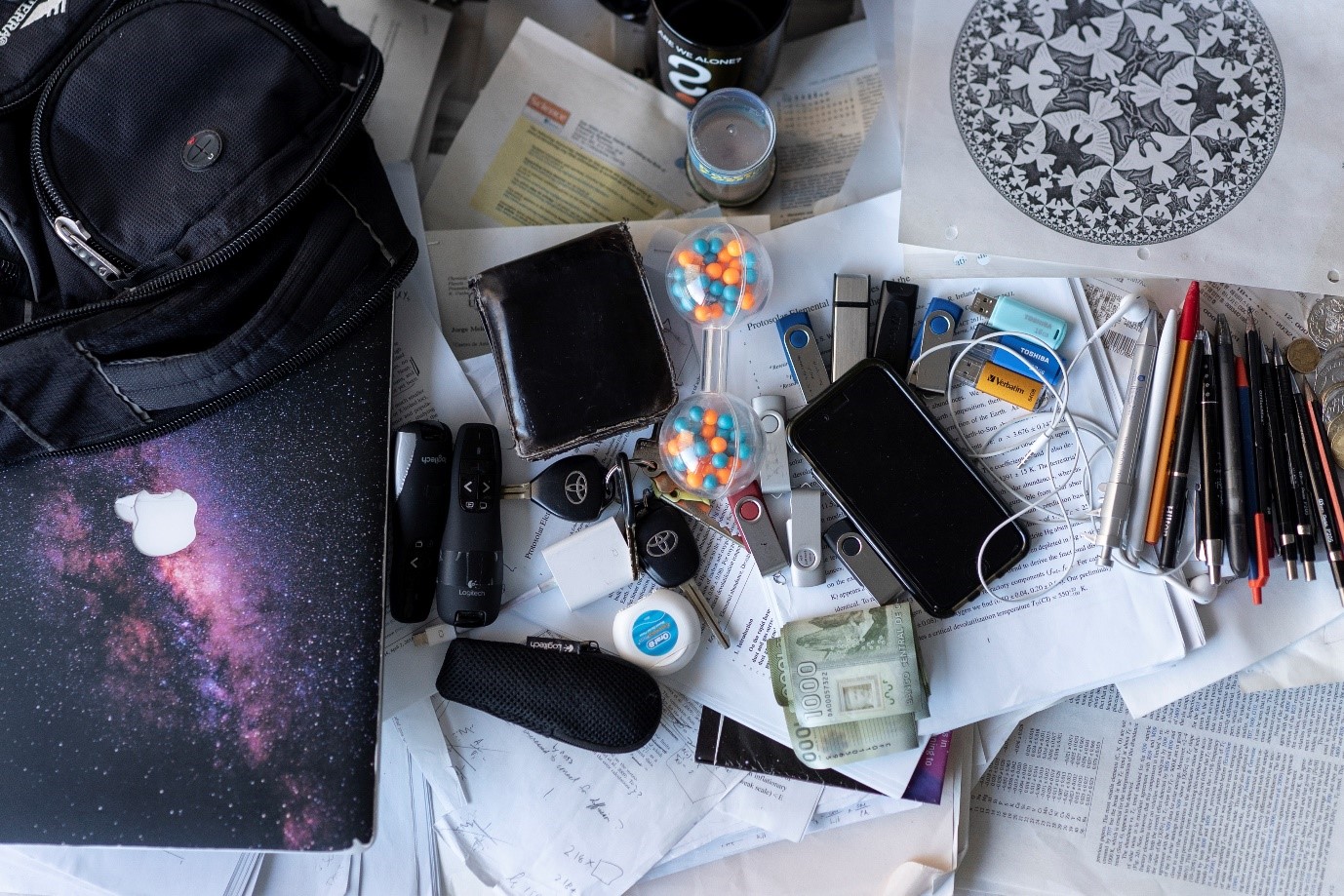
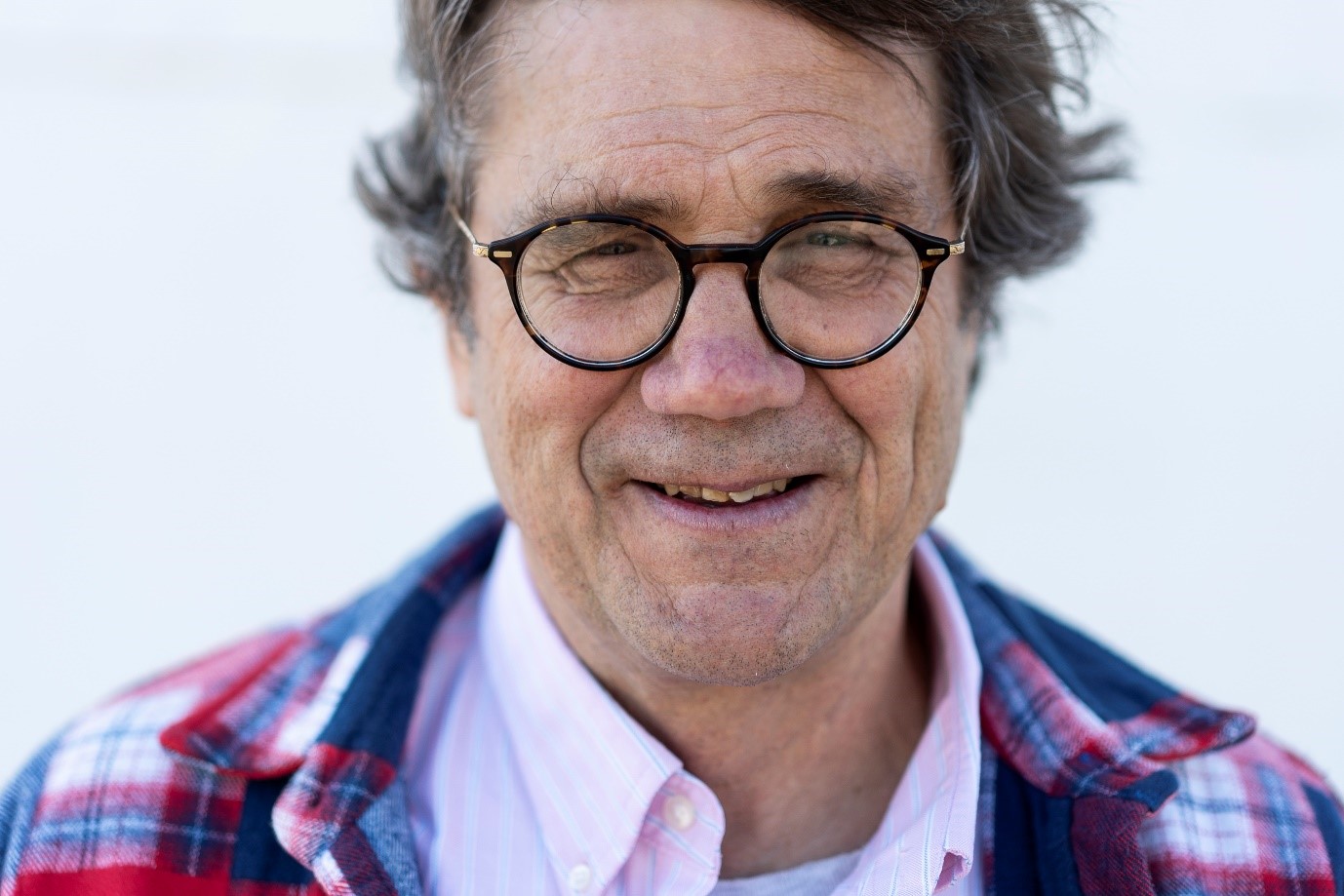
Associate Professor Charley Lineweaver, from the ANU Research School of Astronomy and Astrophysics, researches astrobiology, cosmology and planetology.
- I have a lot of foreign currency, some of which I’m discovering in my bag for the first time right now. 8,000 pesos! This is from Chile where I was speaking at an astrobiology conference about whether or not we need a definition of life. Oh, here’s two dollars from New Zealand!
- The headphones are for podcasts. I like Waking Up with Sam Harris, Sur Les Epaules de Darwin (I lived in France for three and a half years), the Naked Scientist sometimes, Science and Nature magazines. I tried Serial but I didn’t like it.
- The plastic toy I use as a simple demonstration of the second law of thermodynamics in terms of entropy. You try to get all the orange balls over one side and all the blue balls over the other side. That’s low entropy. When you shake it, it mixes up, an increase of entropy. There’s only one way to demonstrate order; there are many more ways to be disordered. The same principle applies to the Universe.
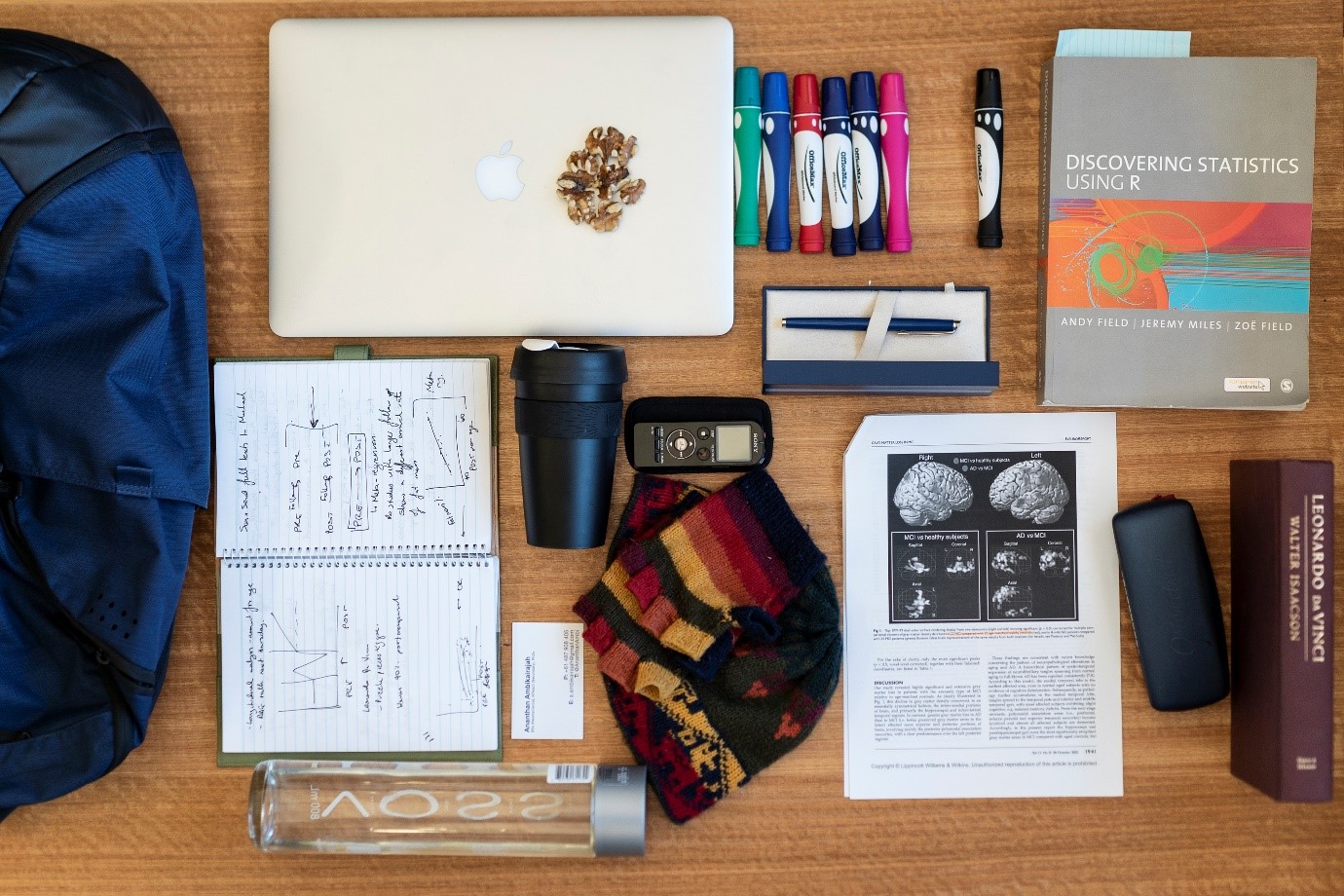

Ananthan Ambikairajah is a PhD student at the ANU Research School of Population Health researching the influence of cardiovascular risk factors on the female brain during midlife.
- I use a fountain pen to do all my writing. I like the idea of writing by hand. It helps with processing, because you have to synthesise what you’re hearing more than if you’re typing on autopilot. It’s also a good way to keep the brain working.
- I’m reading this book about Leonardo Da Vinci which is written by the same person who did the Steve Jobs biography. The cool thing about Da Vinci is that he was actually a scientist as well as an artist and he used each interest to inform his understanding of the other. He used to hire people to dig up graves to dissect their bodies and draw what he could see.
- I have business cards because I have a very long name and it’s hard for people to write down my email address.
- The walnuts are a snack, but they look like brains! I do spend a lot of my time thinking about brains.
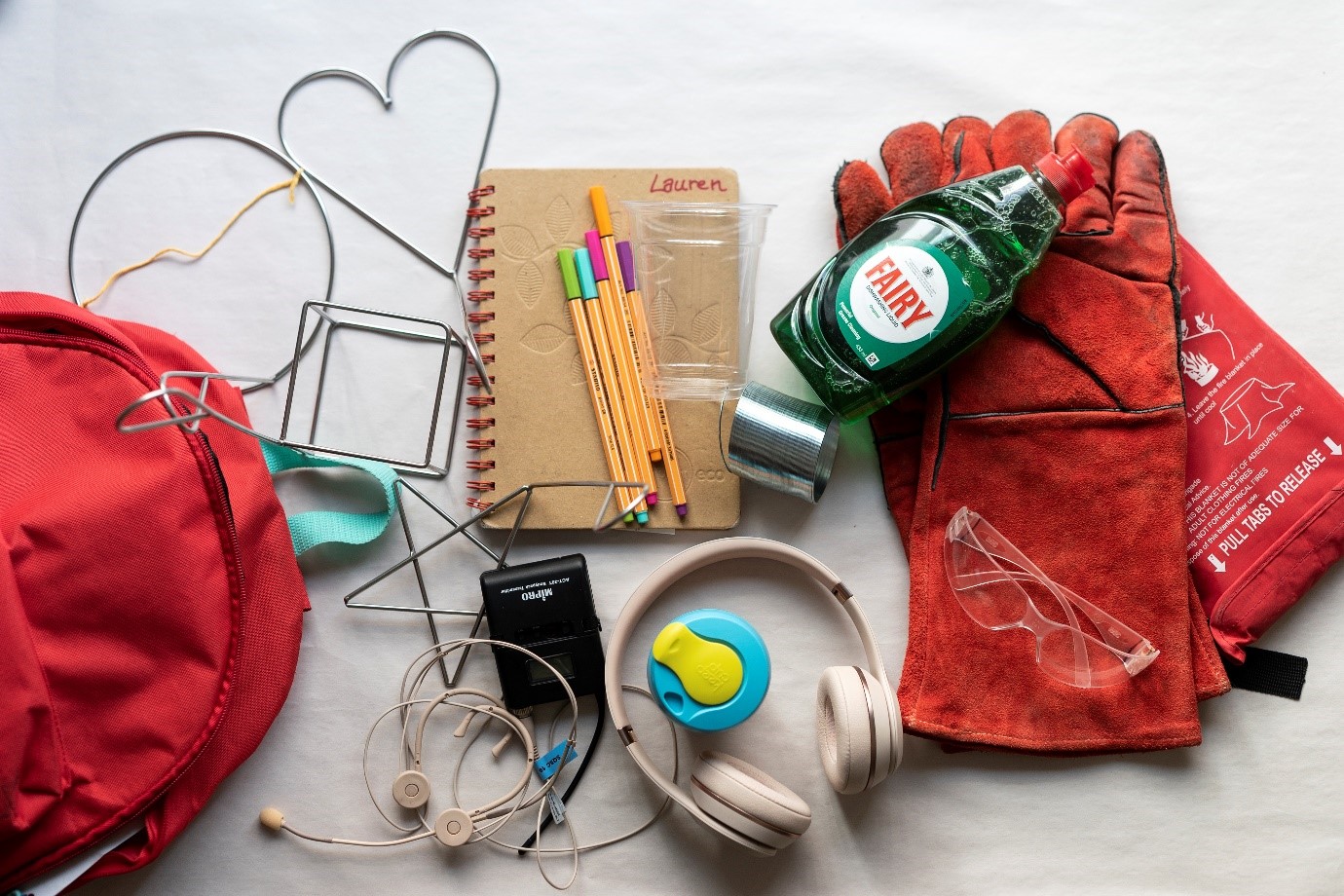
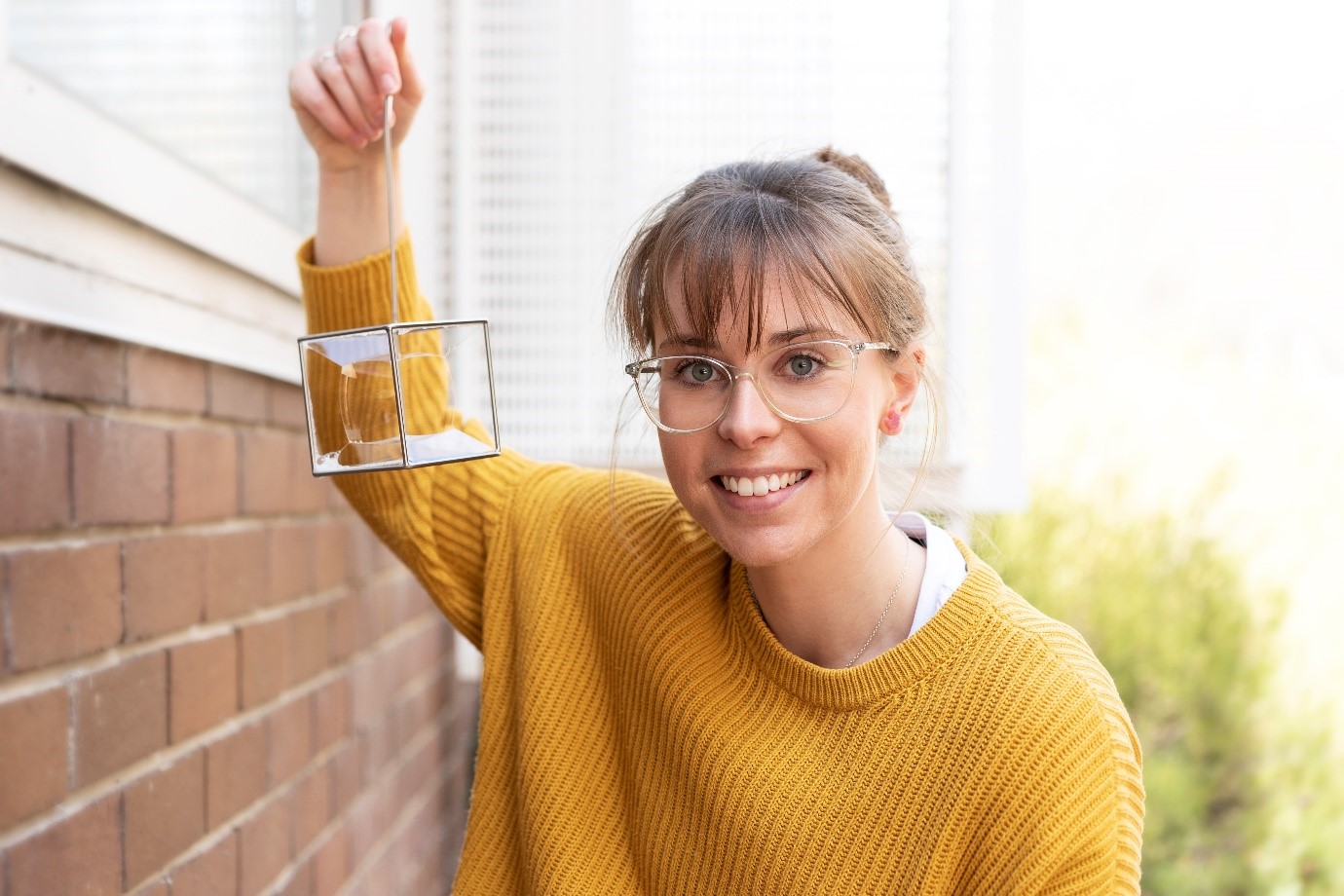
Lauren Sullivan is a student of the Master of Science Communication Outreach at the Australian National Centre for the Public Awareness of Science at ANU.
- These are the props for when I’m traveling around regional Australia with the Shell Questacon Science Circus. We like to use everyday objects to communicate science where we can, like this slinky which is attached to a plastic cup and the vibration makes a noise like a Star Wars laser. If you use a Milo tin it’s even louder!
- For the fire show, where I talk about the science of fire, I have a fire blanket and fire gloves, which I wear for the whole show except for the finale when I hold fire in my hands.
- The bubble wands are to demonstrate how bubbles always want to be a sphere, but I can actually make a cube bubble!
- I have a Madonna microphone for performing the science shows. Going into schools definitely makes you feel like a rock star.
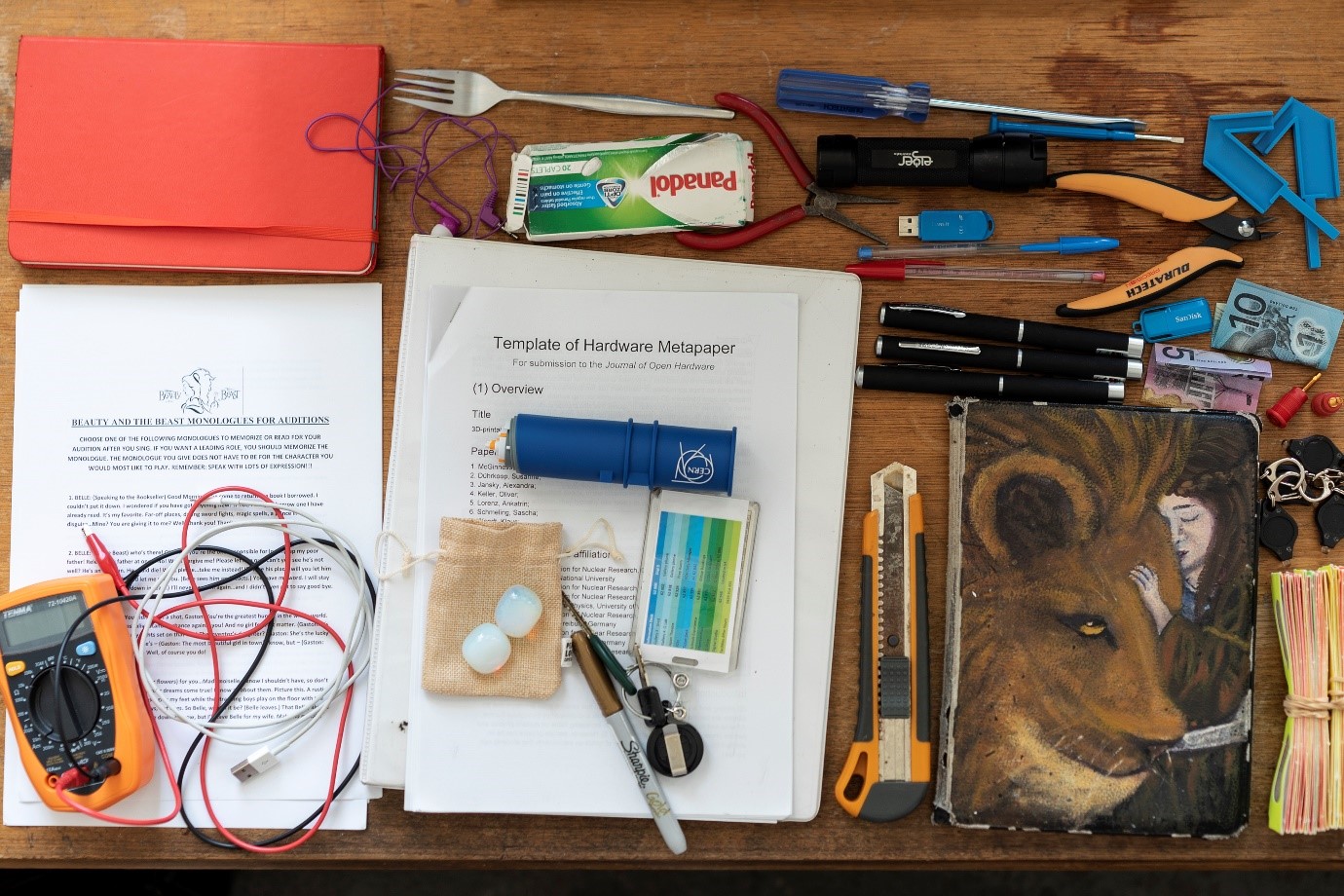
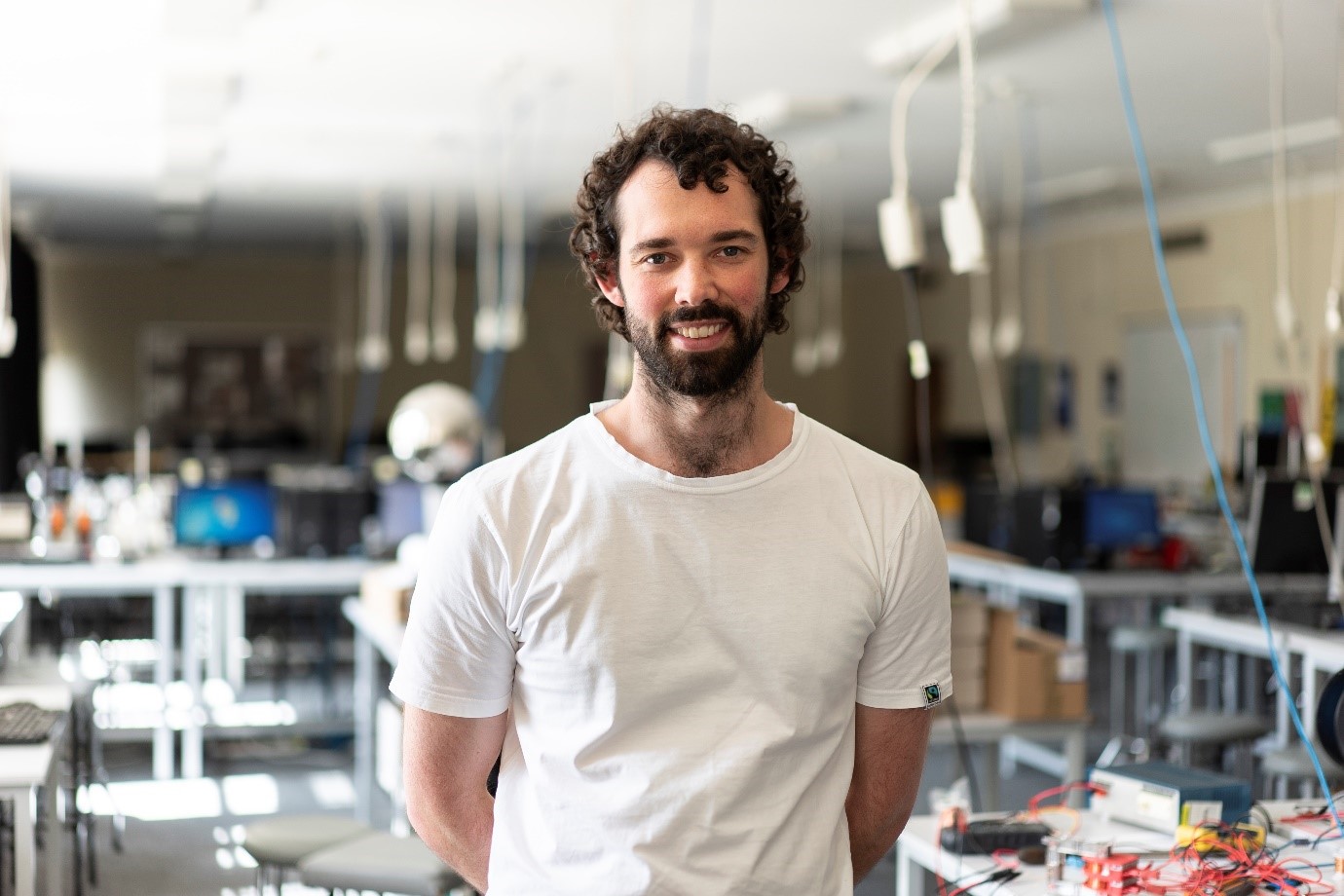
Lachlan McGinness is a Lab Technician at the ANU Research School of Physics and Engineering.
- I have some 3D-printed components from a quadrupole ion trap, a kind of particle trap, which we’re building. If you buy one for the classroom it costs about $8,000, but I’ve designed one which you can build for one hundredth of the price.
- I do a lot of science outreach at Questacon. I do a show about colour and light so I have different-coloured LEDs and some opalite glass, which changes colour depending on whether it’s front-lit or back-lit. It has nanoparticles on the inside which scatter out light - that’s a similar reason to why the sky looks blue but the sunset looks red.
- I like to do musical theatre in my spare time so I have an audition form for Beauty and the Beast. I’m going for Gaston, so I might need to beef up for that! [Editor’s note: Lachlan ended up getting the part of the Beast.]
- I have a red pen because I’m also a high school teacher and every teacher needs a red pen.
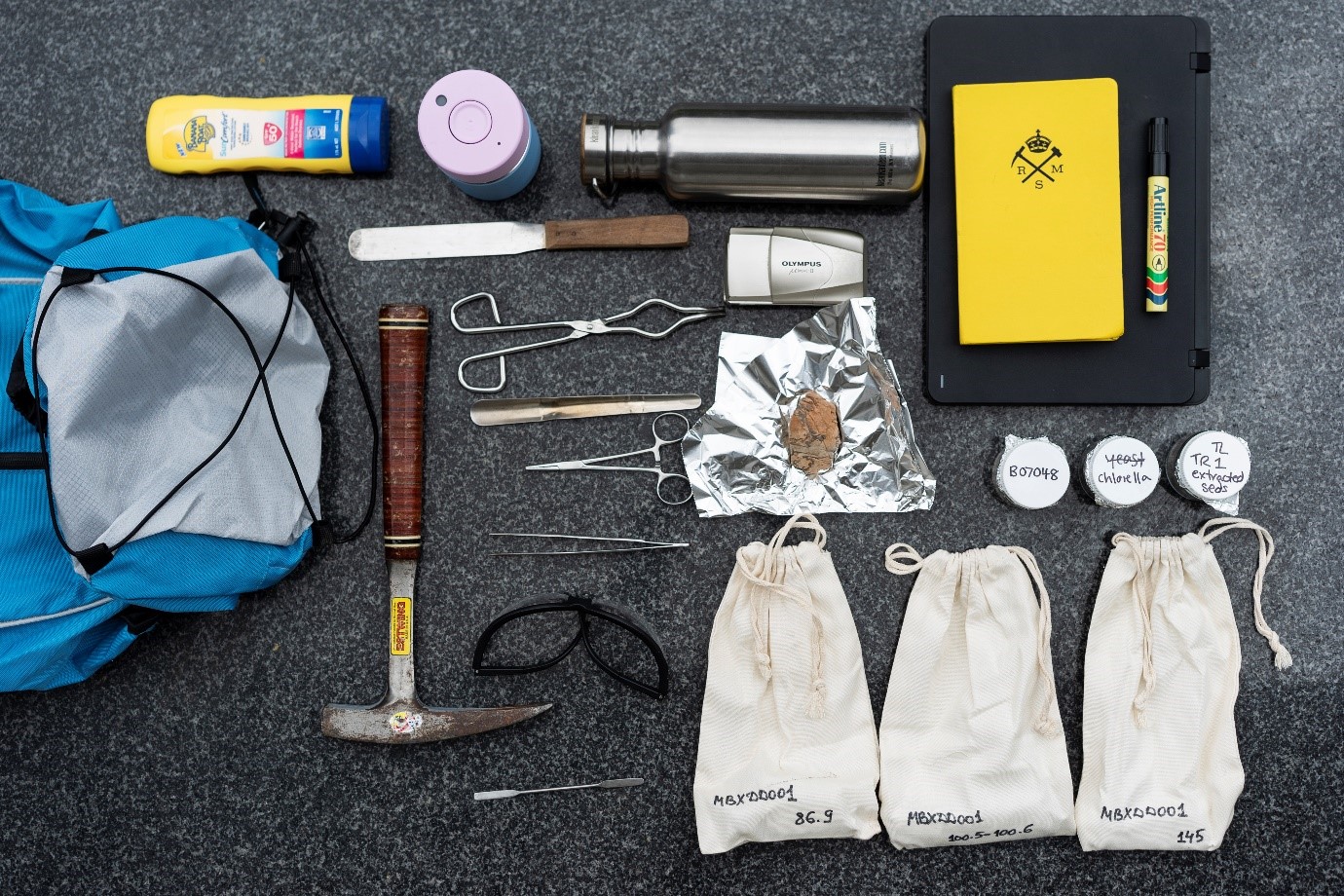
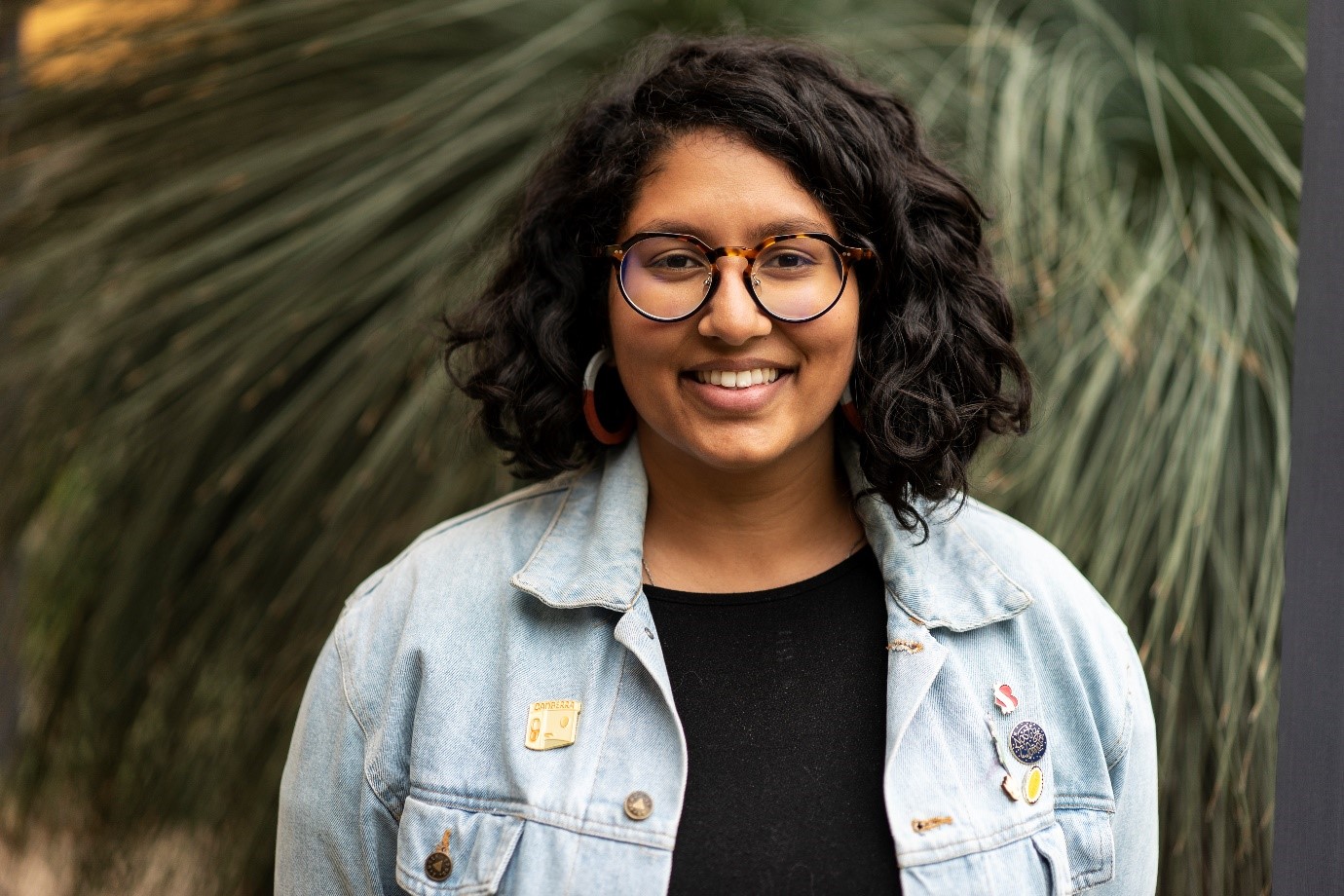
Tharika Liyanage is studying a PhD in paleobiogeochemistry at the ANU Research School of Earth Sciences. She has recently returned from a field trip to the Northern Territory.
- Inside the bags are sedimentary rock samples we’ve collected either from the field or core libraries. We’re hoping they contain organic material which has been preserved for millions or billions of years, so we can learn more about primitive microorganisms and the environments they live in. This will further our understanding of the early evolution of life.
- We use all these instruments to handle the rocks to avoid contaminating them with the cholesterol we have on our hands. The samples are also wrapped in baked aluminium foil to protect from outside organics.
- The camera is an old film camera for my personal use. When I take photos of samples, I just use my phone, but film photography is my creative outlet.
- The coffee cup is essential. You definitely need coffee in the field. There were a lot of fights on our last field trip about there not being enough coffee!
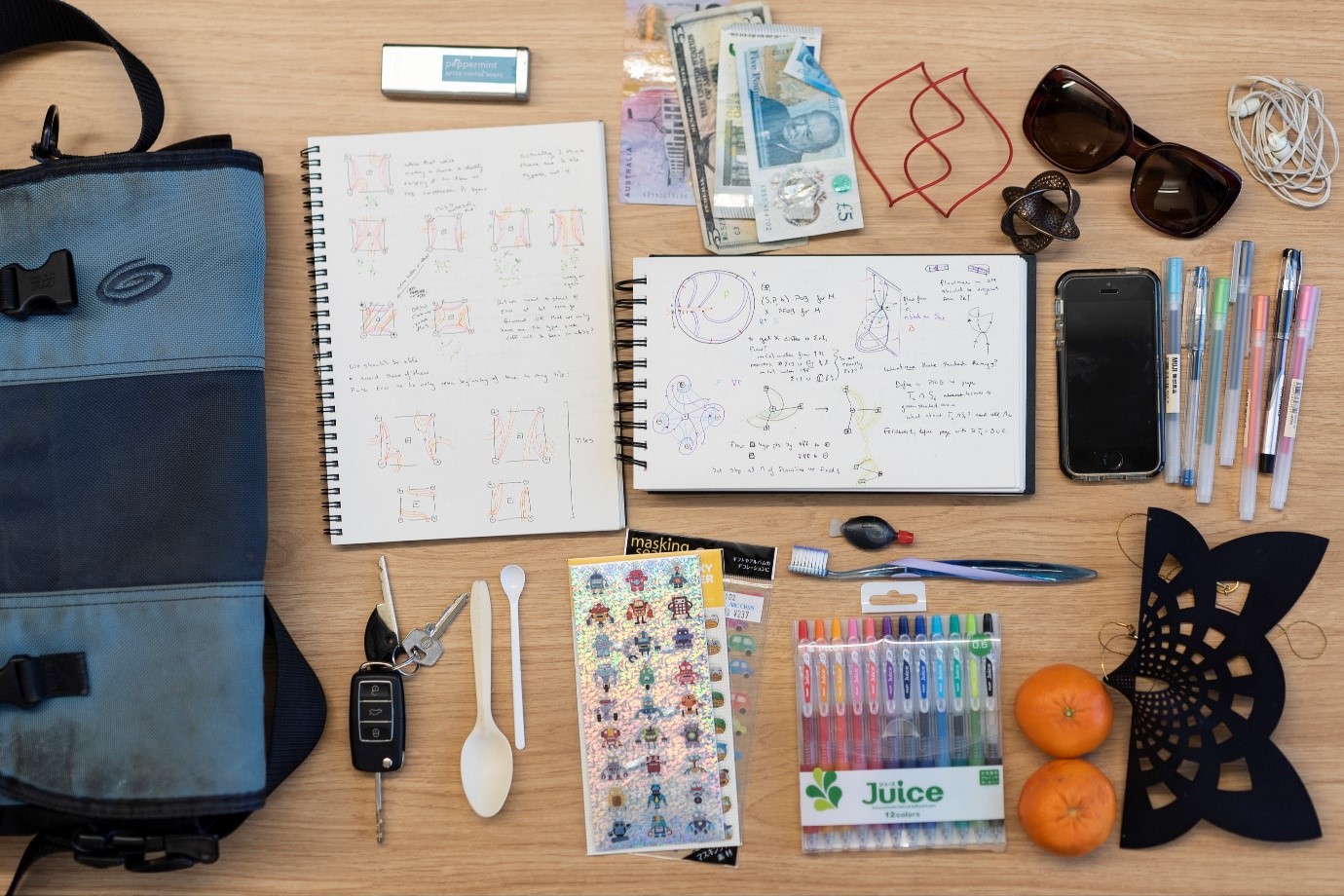
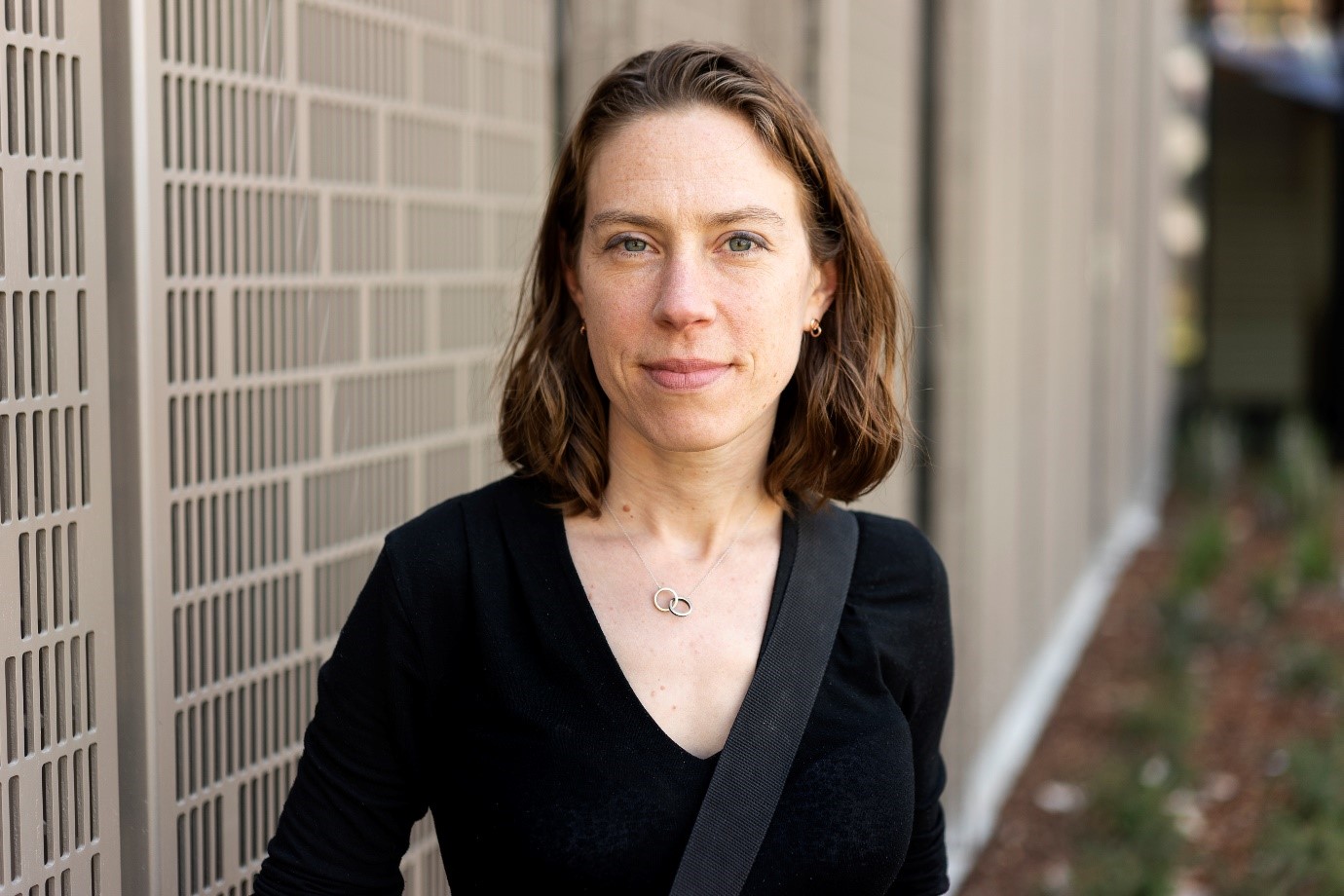
Dr Joan Licata, from the ANU Mathematical Sciences Institute, researches topology and contact geometry.
- The drawings are really part of my research process, not just pretty pictures! My speciality is low-dimensional topology, specifically dimensions four and down, so one of the skills required is figuring out how to encode actual deep content into these pictures.
- Knot theory is one of my areas of study so I’ve included a few examples of mathematical knots: the red wire loop is a knot, while the flat black object and the round bronze one are surfaces whose boundaries are knots. A mathematical knot is like a loop of string you're not allowed to cut.
- In pure mathematics, we don’t have a lot of equipment needs. The major expense of my research is travel to be face-to-face with my collaborators. Travelling is why I have the foreign currency and the stickers, which were a gift for my kids from Japan.
- The spoons are from a family trip to Vanuatu last week. I don’t like throwing anything useful away!
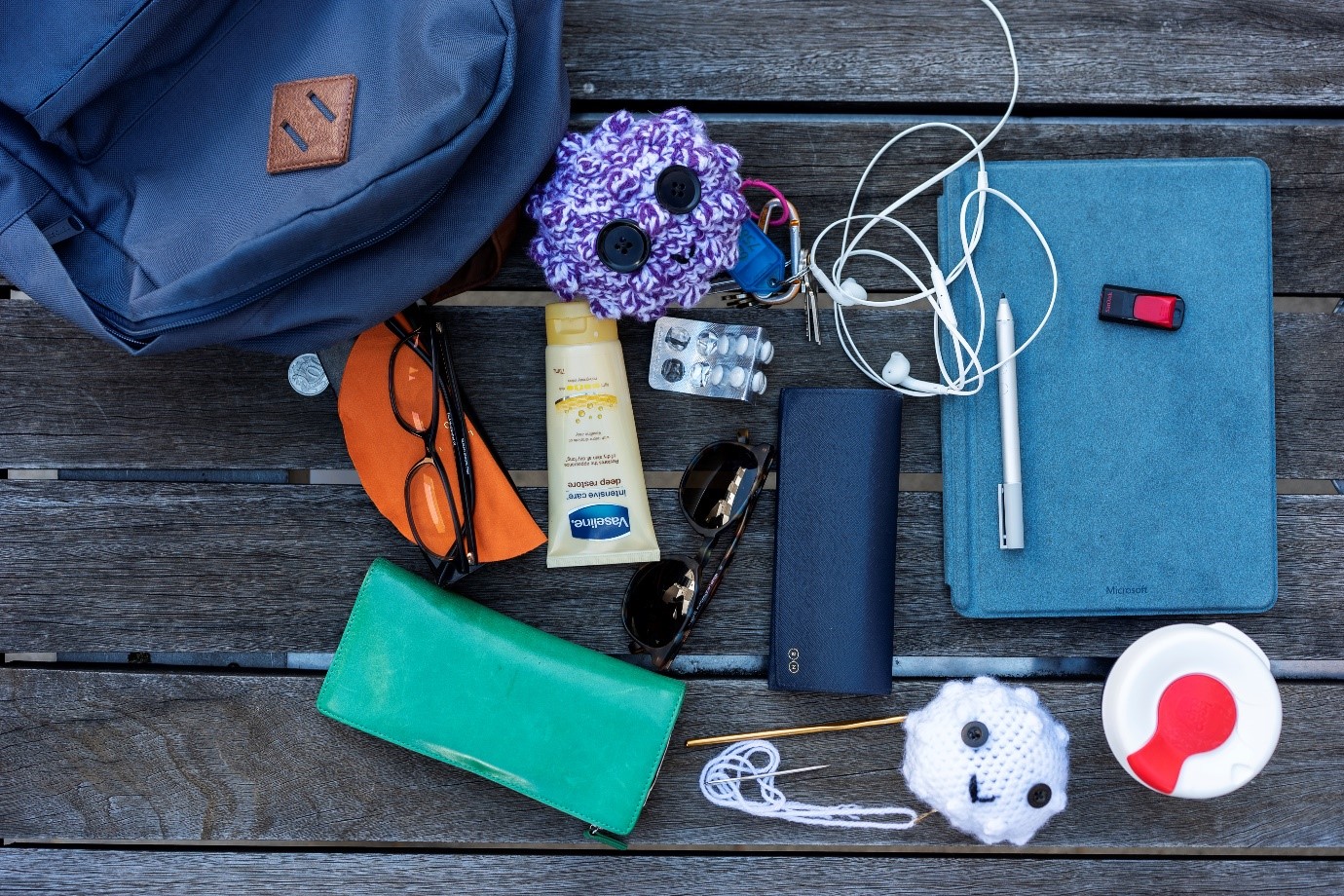
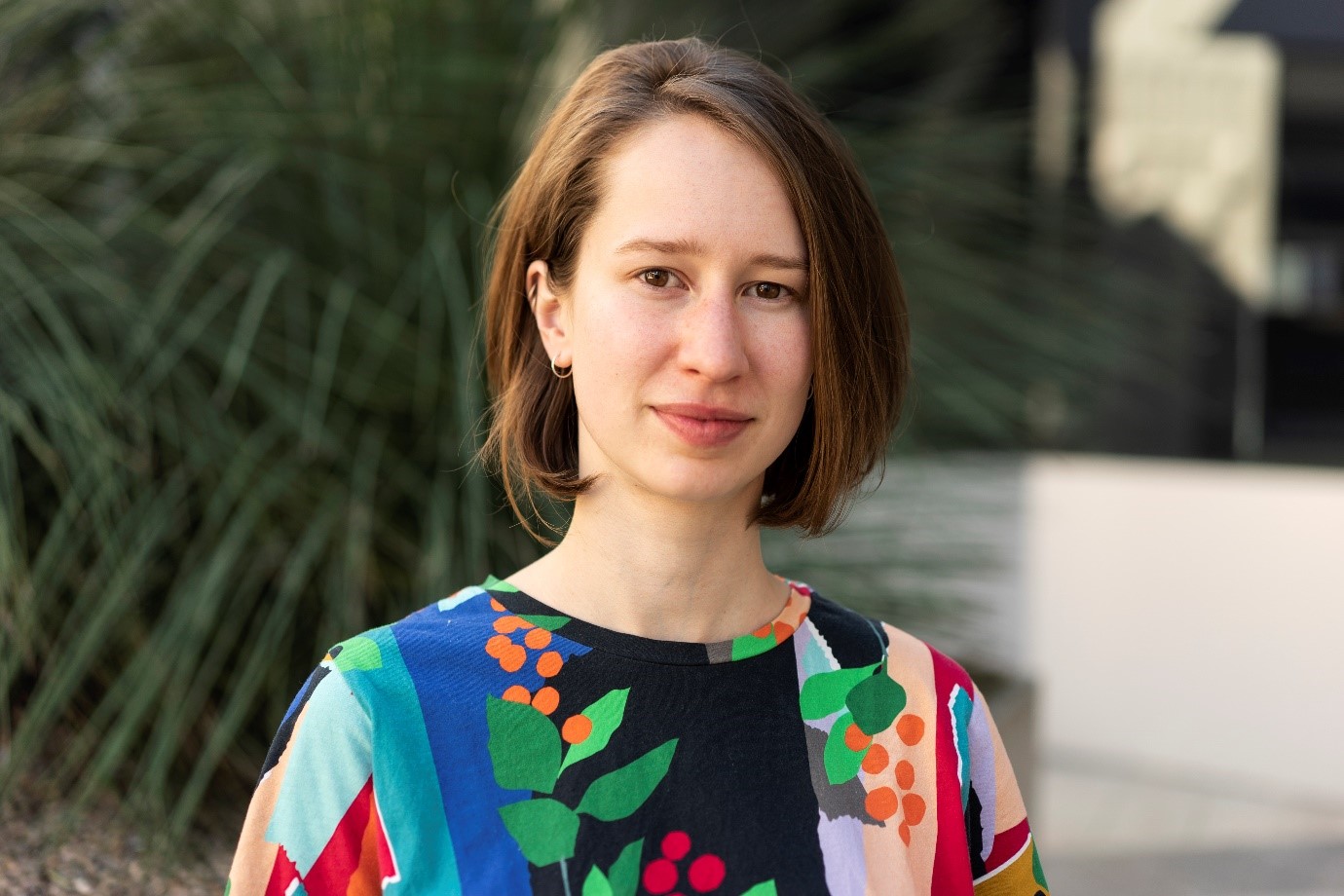
Alicia Wilson is a PhD student at the John Curtin School of Medical Research at ANU, studying immunology.
- I crocheted these little cells for a multiple sclerosis fundraiser we held because our lab’s research focus is on MS. The white one is a lymphocyte and the other one is a neutrophil, which is a different type of white blood cell, but I made him purple because they come up purple when you stain them in the lab, which is how we know they’re neutrophils. It’s important to do work in the community so we’re not just looking at cells without thinking about the people who actually have MS.
- My PhD is on the interactions between these two types of cells, the lymphocyte and the neutrophil, in inflammation such as MS. There’s a lot of lab work, which is where I keep all my equipment. The headphones are for drowning out the lab noises. It’s nice to have some background music so you’re not standing there for eight hours listening to the whirring of machines.
- The crochet hook is for making the cells, obviously. I crochet while watching crappy TV. I watched a lot of Downton Abbey in the lead-up to the fundraiser.
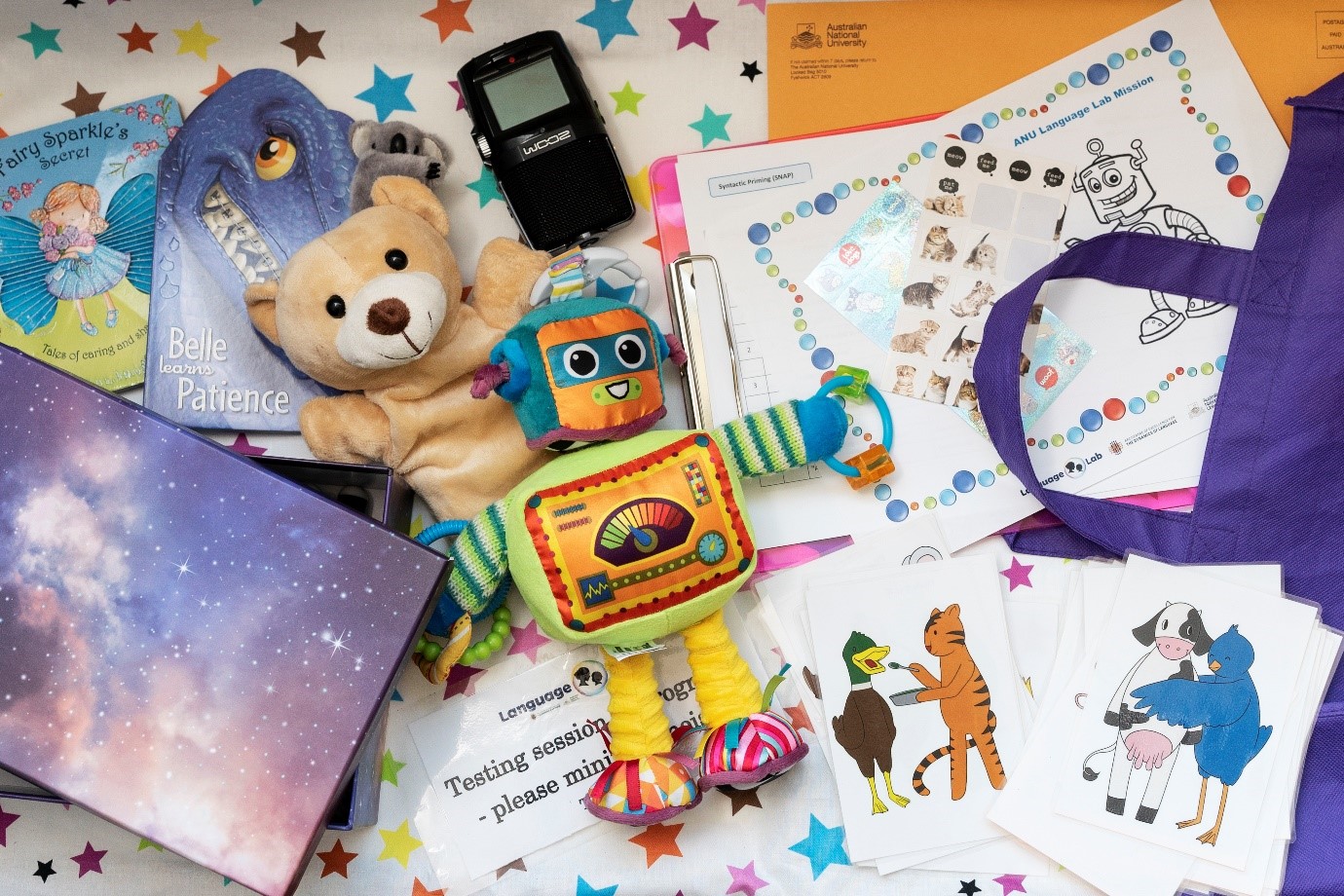
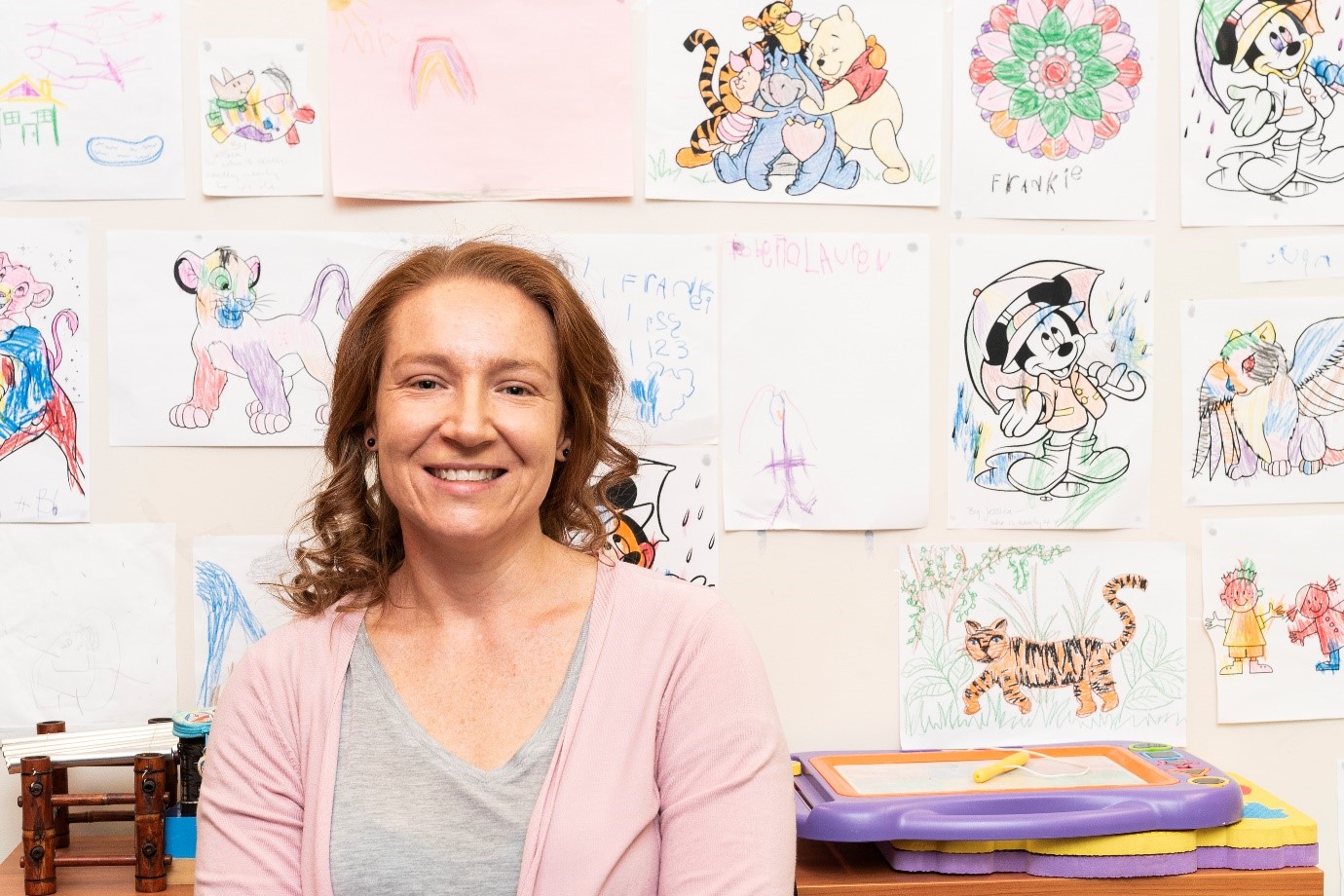
Amanda Piper is Project Coordinator for the Language Lab at the ANU Research School of Psychology which is conducting research into children’s language acquisition.
- Our project is following the language development of a group of around 120 kids. We started when they were nine-months old and now they’re almost five. When the kids come into the Language Lab, these are the items we use to interact with them.
- The robot is Rusty, our lab robot. He teaches the kids ‘robot language’, which is actually phonemes I play from a laptop. The kids listen and repeat back the sounds.
- The picture cards are for a game we play where we take turns flipping over the cards and describing what the animals are doing on them, and if the pictures match, the kids can say ‘snap’. I always lose, of course.
- We also have toys to use as prizes when kids ‘win’ the snap game. They also get paid ten dollars’ remuneration for their time. Some of the parents are banking the money, or donating it, or having a babycino date after their session. Sometimes they’re having so much fun, it’s hard to get them to leave!
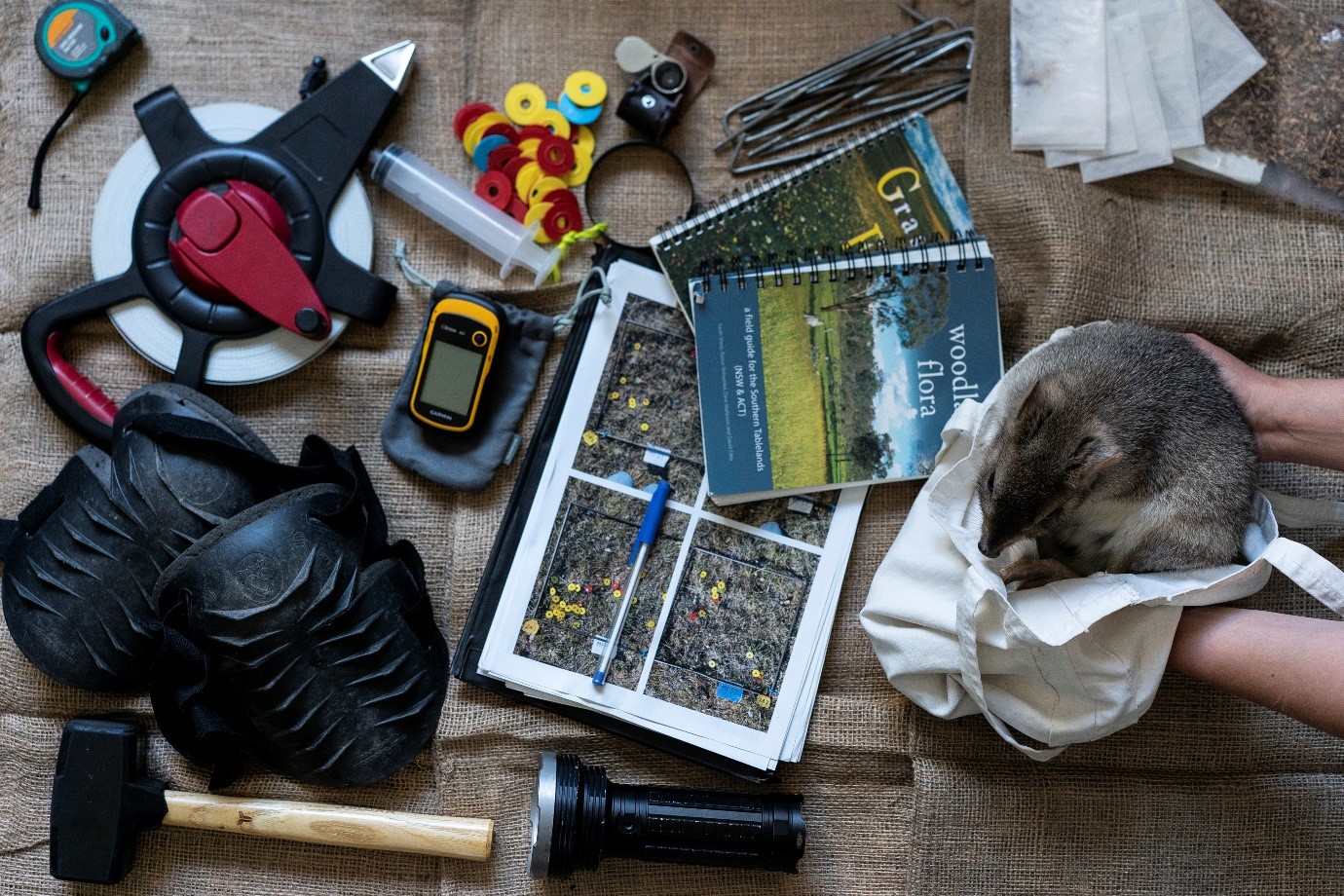
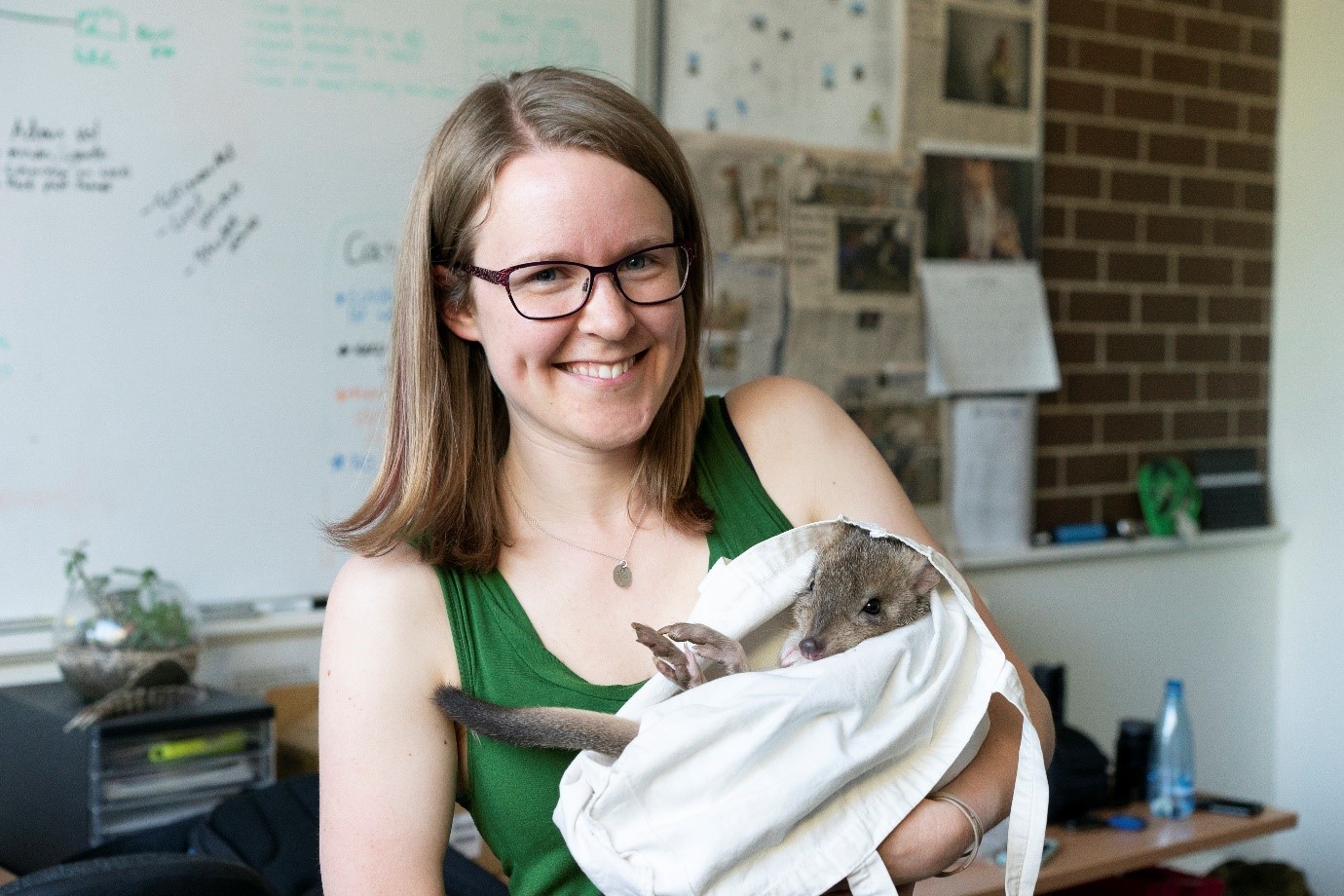
Catherine Ross is a PhD student at the Fenner School of Environment and Society at ANU, studying restoration ecology.
- I’m researching the effect of the eastern bettong on the soil and plants in Mulligan’s Flat Woodland Sanctuary, where the bettongs have been re-introduced. I would not typically have a bettong in my bag, no. This is Brian the Bettong, who does engagement activities with schools to promote his role as an important ecosystem engineer.
- I’m looking specifically at bettong diggings, which they create as they forage for truffles and tubers, so I need the kneepads because I’m always kneeling on the ground. The mallet and pegs are to mark where the diggings are, and there’s also an egg-ring to give a consistent plot size.
- I have found that bettong diggings provide a great place for seeds to germinate. I’m often looking at tiny seedlings to see which species are coming up, so I use a hand lens and the field guides to help identify them and then mark them with the coloured circles. I also have seeds for adding to the diggings. One of the concerns when the bettongs were brought in was that they might encourage weeds, but it seems the natives are benefiting more.
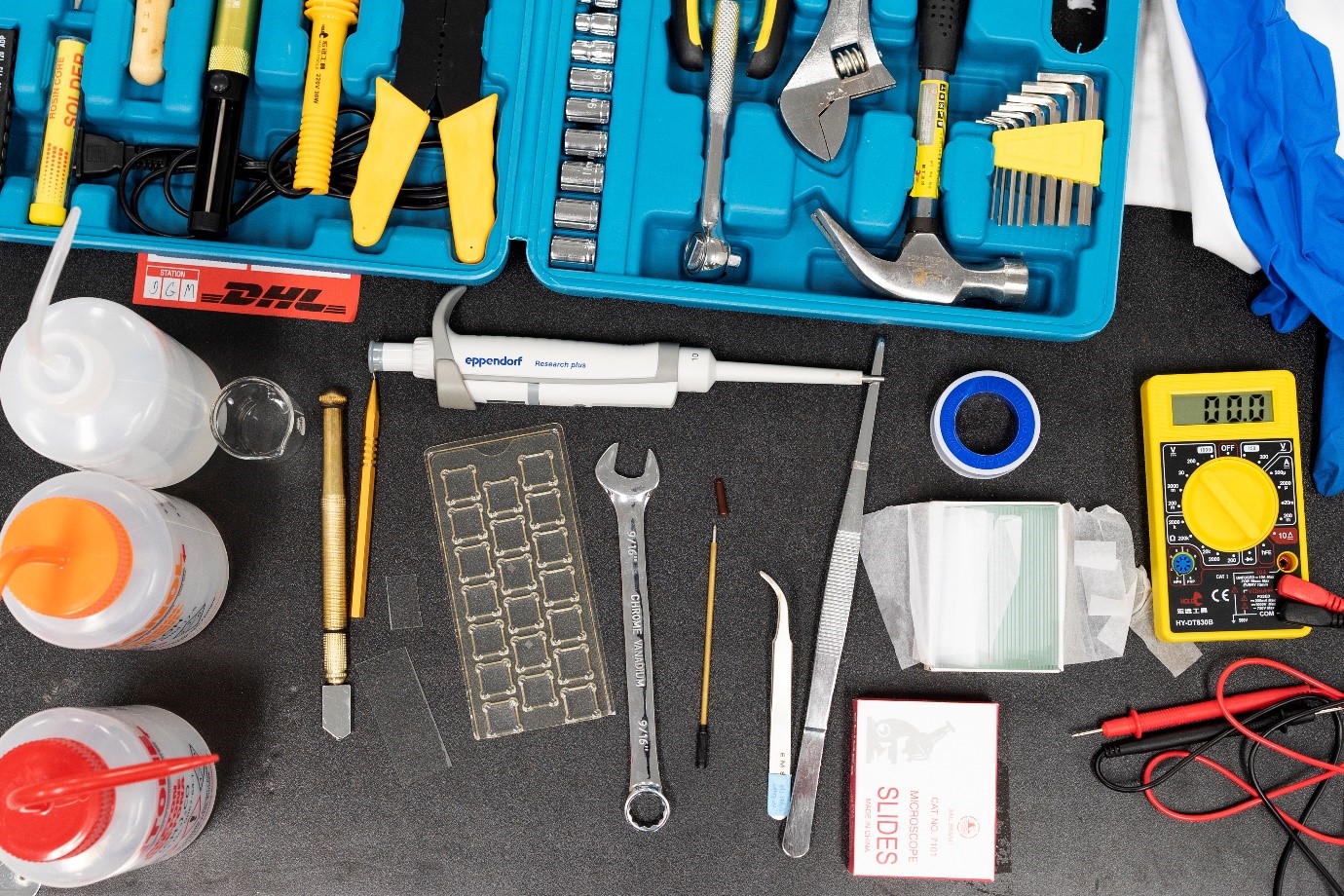
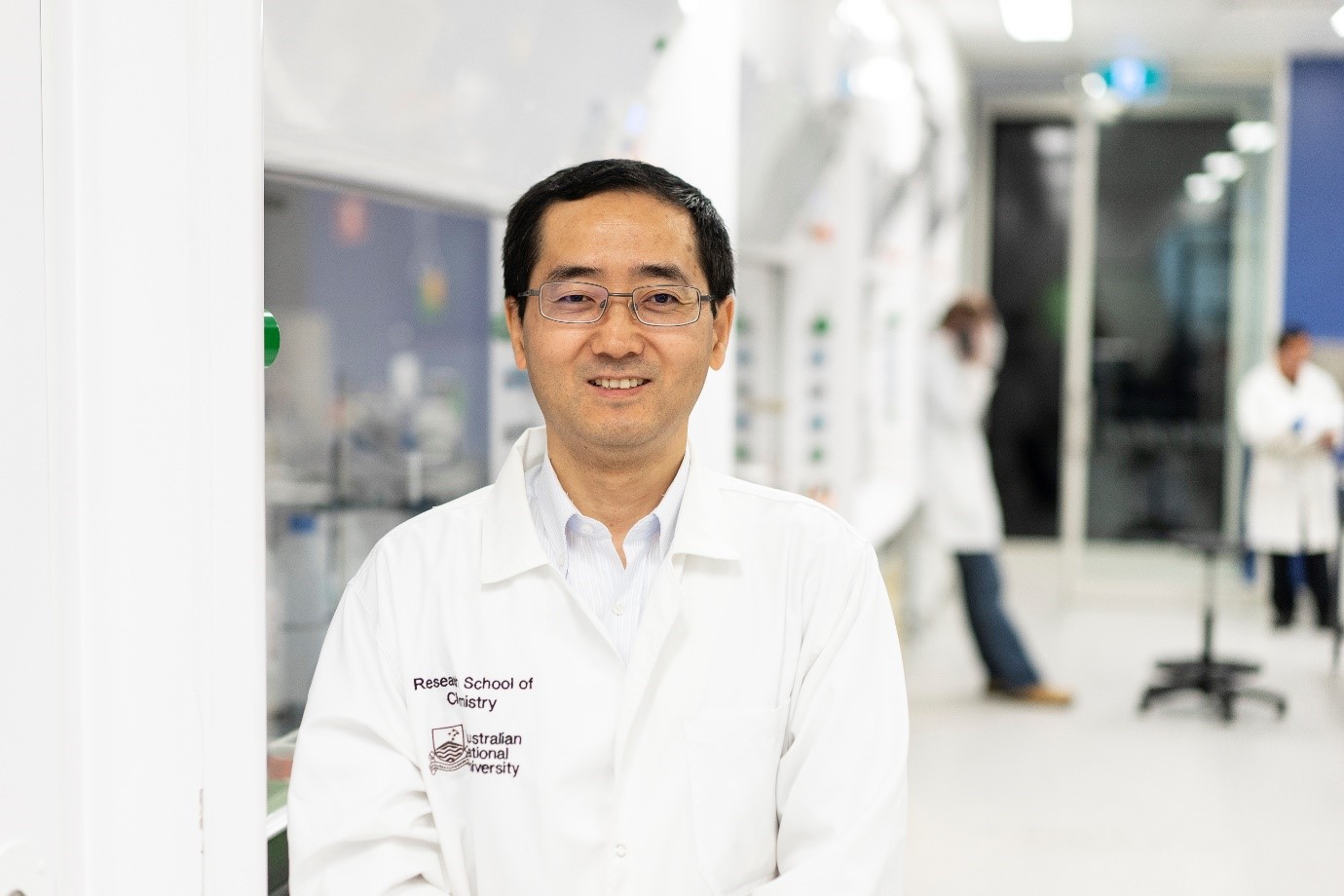
Dr Zongyou Yin, from the ANU Research School of Chemistry, researches nano-to-atomic materials and applications.
- In this clear plastic casing are two very tiny, flat, artificial diamonds which we purchased commercially. We then grow atomically thin hydrogen layer on the surface of the diamond, about hundred thousand times thinner than a human hair. We then add few layers of hydrogenated molybdenum oxide. This makes the diamond into an extremely tiny, extremely tough transistor. It’s strong enough to be potentially used in a rocket engine.
- There’s another diamond here too: a diamond pen which is so strong it can cut substrate, and this glass slide.
- The multimeter we use to test conductivity. The diamond does not have surface conductivity at the beginning, but when we modify it with the monolayer of hydrogen, it becomes conductive, so we can put electrodes on top to make the electronic device.
- A lot of this equipment might look more like it belongs to physics than chemistry, but my research puts the two together.
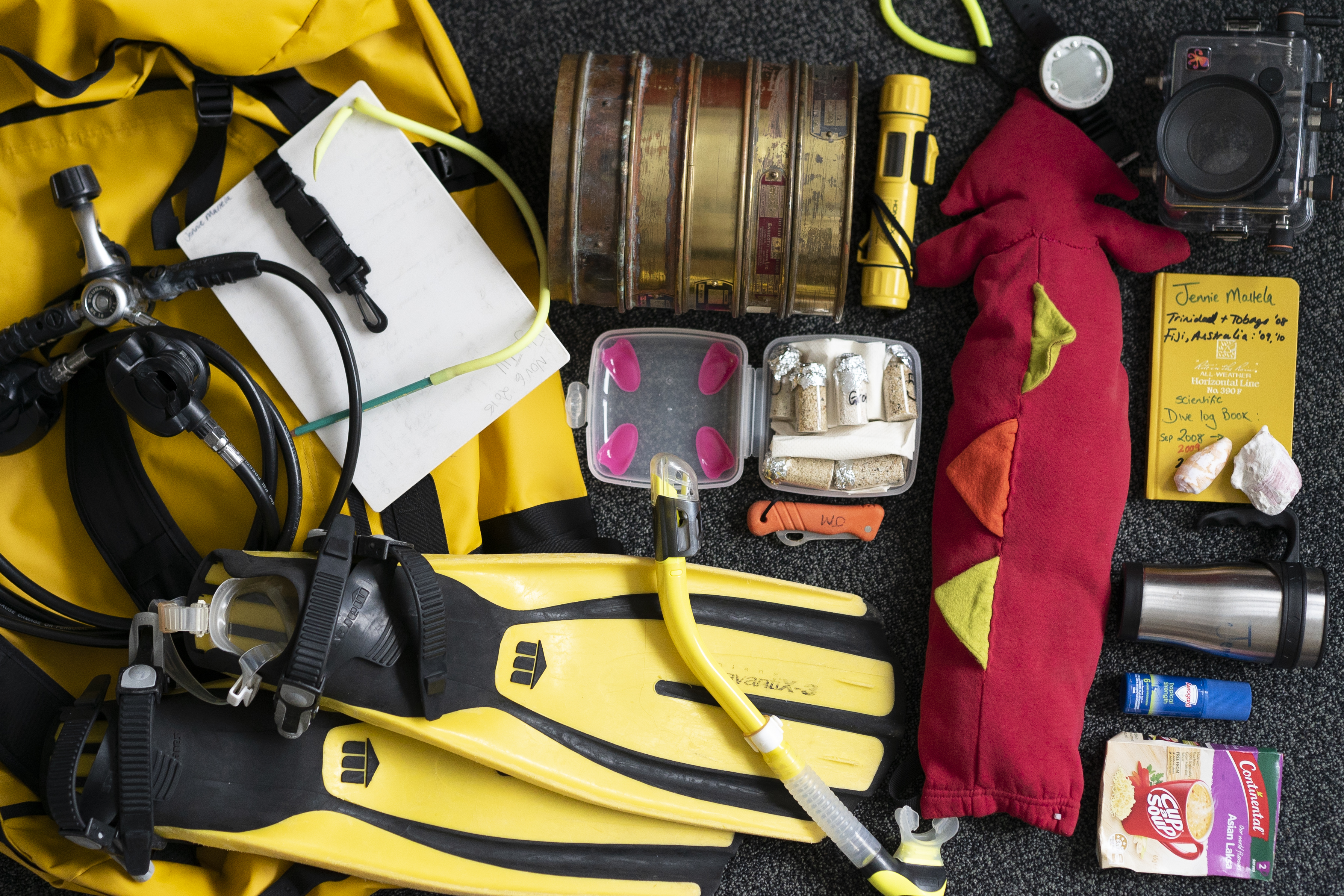
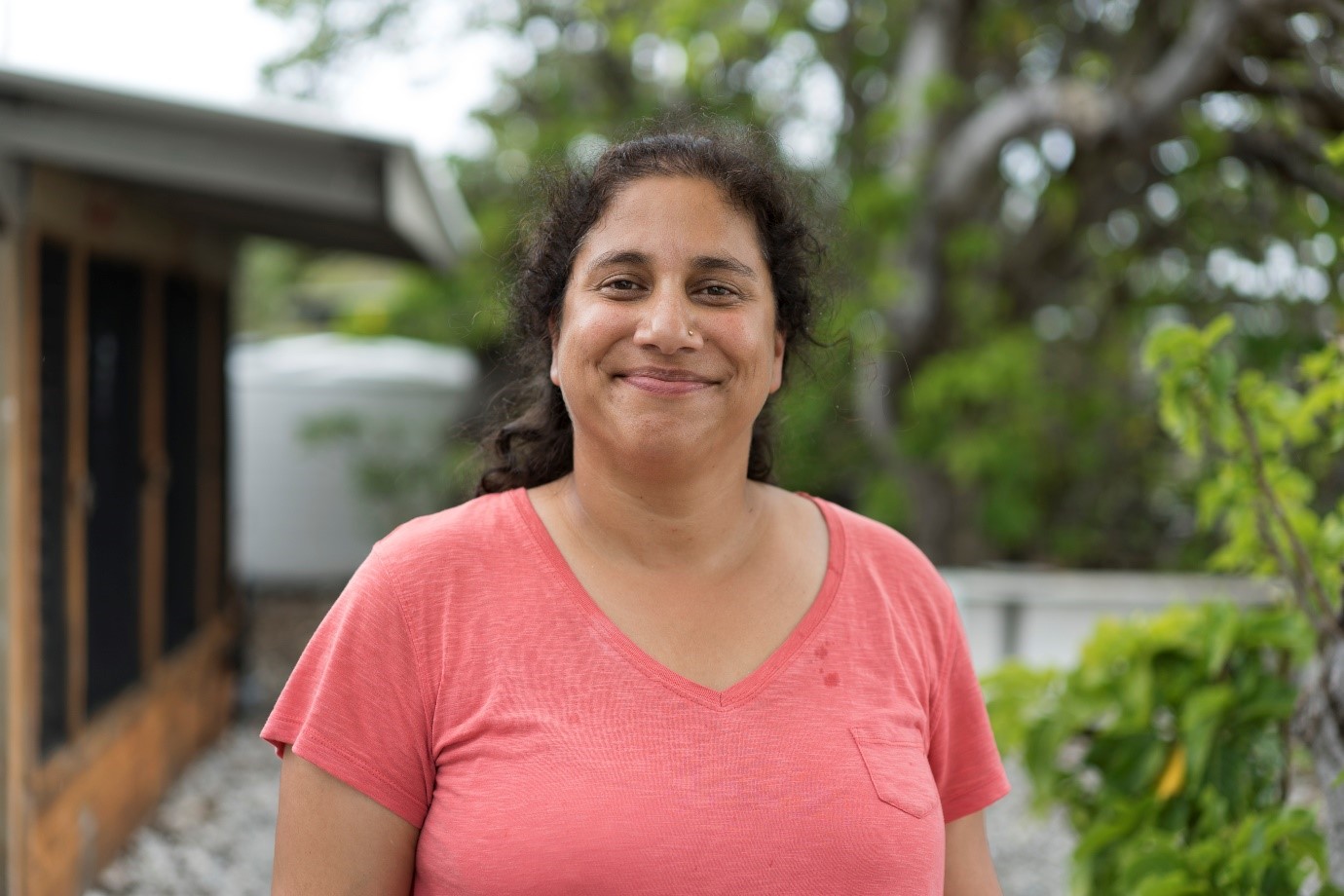
Dr Jennie Mallela, from the ANU Research School of Biology and the Research School of Earth Sciences, researches environmental ecology. She has just returned from fieldwork on Christmas Island.
- On Christmas Island I’ve been collecting coral cores to reconstruct climate change. We got a 2.7-metre core, which in theory should represent 270-ish years of data, which is very cool.
- The camera casing is for recording video transects for my research on coral reef recovery after bleaching. Christmas Island is actually a good news story, because the coral is coming back.
- The sediment samples I’m going to analyse for presence of microplastics. There pretty much isn’t a beach in the world that doesn’t have plastic in the sand, and I want to see if it’s making its way all the way down to the reef.
- The dinosaur tail is because I always like to have toys on me to entertain my son or any kids who are hanging around.
- The dive knife is to collect samples or to free myself from fishing line. And often when I stay places they have rubbish knives so I use it for cutting my food too.
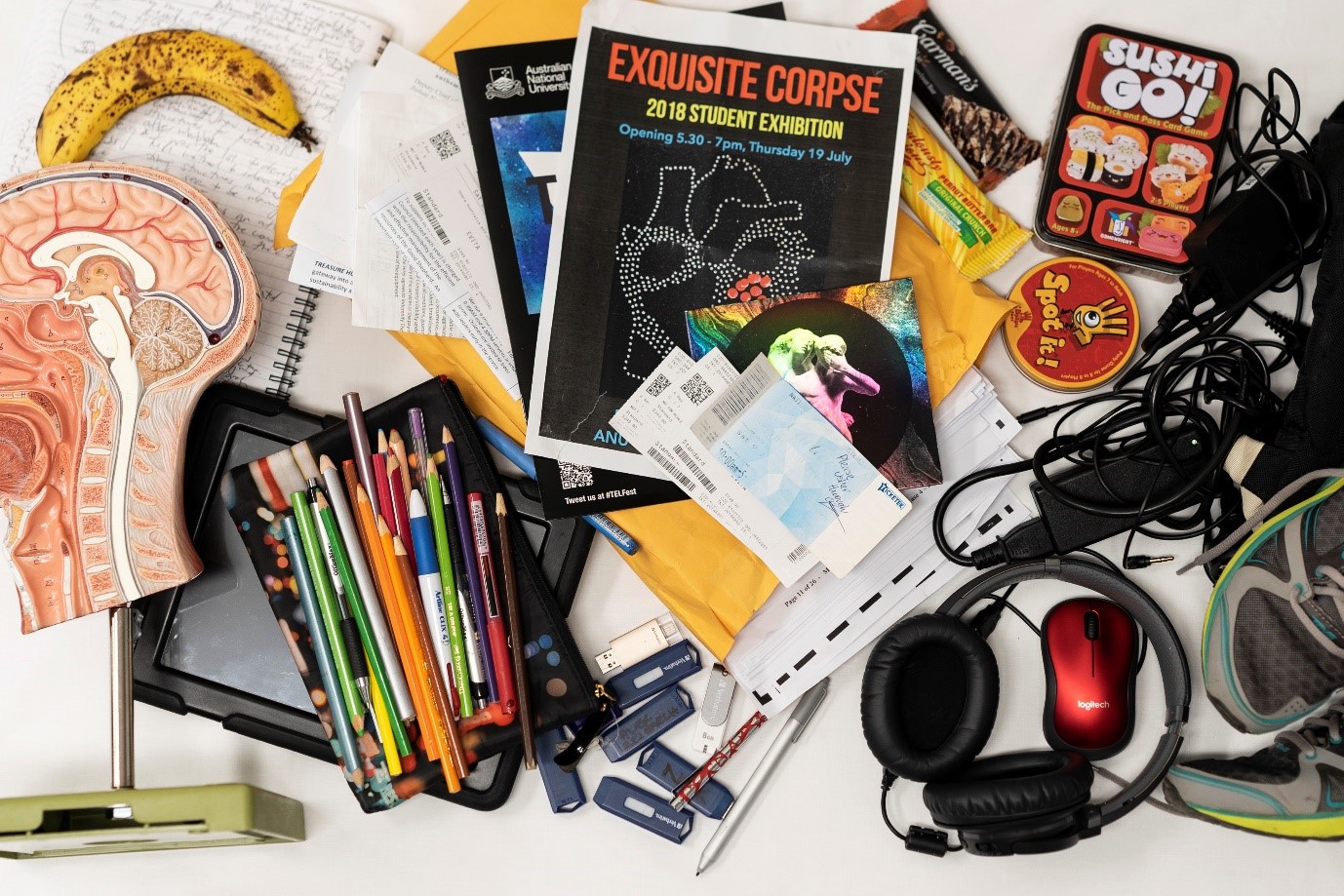
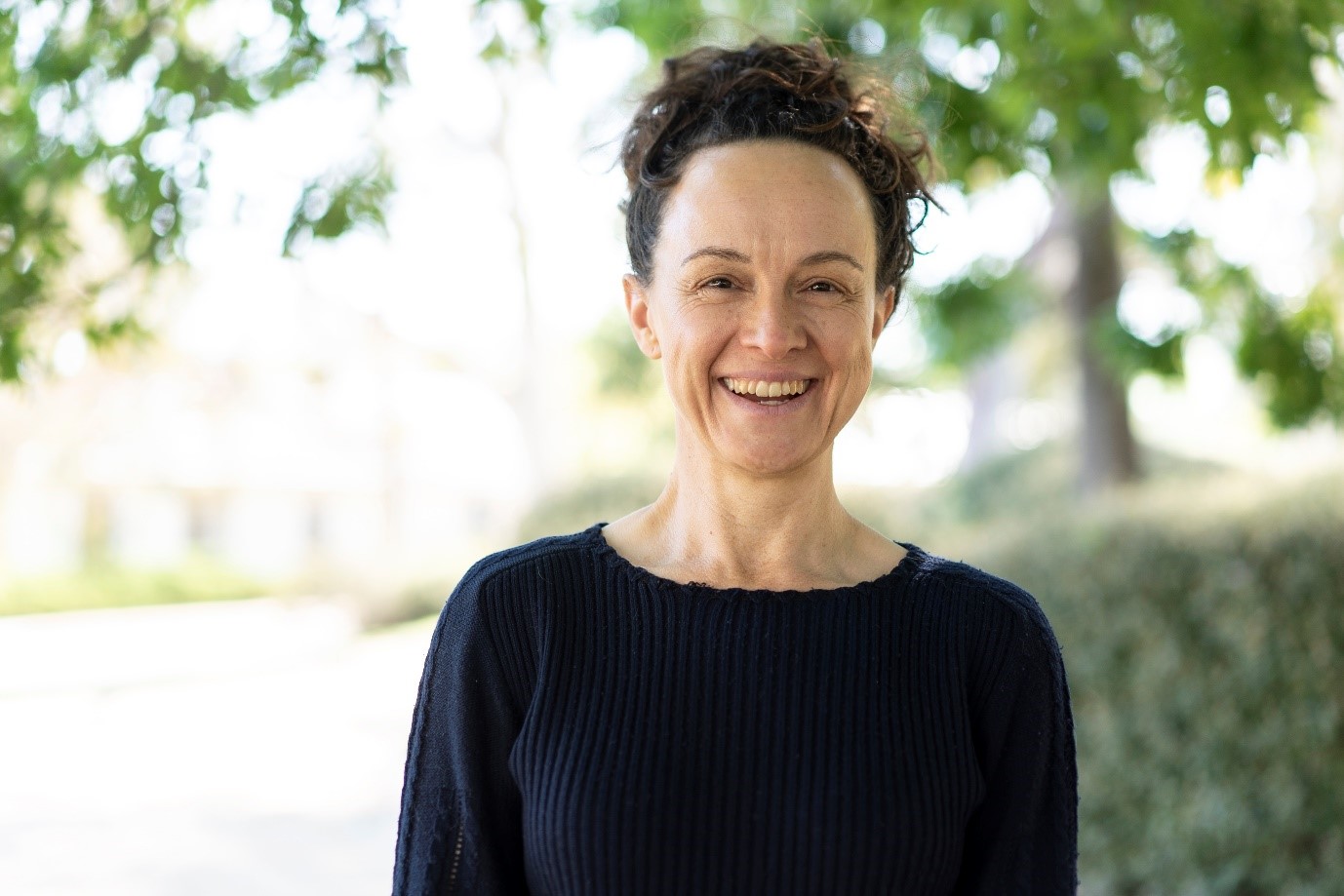
Dr Alexandra Webb researches and teaches anatomy at the ANU Medical School and the ANU Research School of Biology, and leads technology-enhanced learning and teaching in the medical program.
- Why do I need so many USBs? Because I collect information! For my research I use MRI data and that takes up a lot of space. We also do micro-CT models of different body parts which we use to make virtual reality, interactive touch screen and 3D printed models. Having access to this kind of technology means students can prepare before they come into the anatomy lab and maximise the hands-on time they have with the specimens.
- The games are for playing with my nine-year-old daughter, who is very accommodating of my work life.
- The pencils are for me! We do a lot of colouring and drawing in our anatomy classes to see visually how the different structures of the body fit together.
- The flyer for the Exquisite Corpse exhibition comes from a cross-disciplinary art and anatomy course which I convene. We use visual art techniques to learn anatomy, and also use anatomy to enhance the art students’ understanding of the human body. Then the artists and the scientists have an exhibition at the end.
